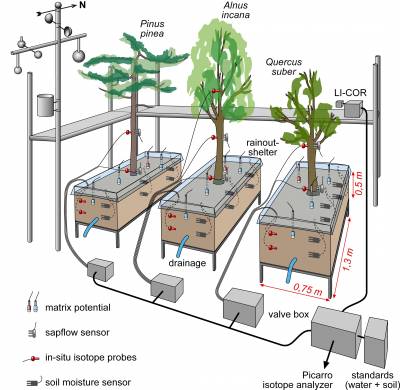Intercomparison of plant water extraction methods for isotope analysis
Background
An increasing number of scientists and disciplines around the world are benefitting from the application of stable water isotope techniques (δ2H and δ18O), especially in plant ecology and ecohydrology. Investigations of ecohydrological processes using such techniques have improved our understanding of soil water dynamics (1) and patterns of plant water use (2). In this regard, the analysis of the isotopic composition of xylem water has been applied to determine the source of water used by plants under the assumption that there is no fractionation during the uptake process by roots and water transportation (3). The basis of this approach is that the potential water sources available to plants (i.e. groundwater, deep and shallow soil water or surface water) show contrasting isotopic signatures (1, 2). Thus, the accuracy on determining of sources and plant water isotopic composition is crucial to understand ecohydrological processes. For this reason, a lot of effort has been put into developing methods to extract water from soils (4) and plants (5). However, a critical issue is that we know little about which water extraction method captures which water pool in the soil (more mobile to tightly bounded water to the soil matrix), and within the plants (stored intracellular water vs. water contributing to the transpiration stream). Yet another issue is that plants produce a wide range of organic compounds that can interfere with water isotopic measurements (6, 7). Identifying the techniques that can accurately represent the physiologically meaningful water pools in plants and soils, is key to improve our understanding of ecohydrological processes and test some of the new hypothesis that are shifting paradigms in hydrology (8).
Aim
In this study, we will compare different isotopic sampling techniques in plant and soil that involves in situ measurements of δ2H, δ18O, δ17O and different destructive water extraction techniques (e.g. centrifugation, water vapor equilibration and cryogenic extraction). This study goes beyond traditional investigations by combining for the first time multiple techniques in a well-controlled set up over different tree species (Fig. 1).
 Fig. 1: Experimental setup including ecohydrological and isotopic measurement equipment.
Fig. 1: Experimental setup including ecohydrological and isotopic measurement equipment.
Against this background, the potential candidate would:
- Extend an existing tree pot experiment
- Compare in-situ (vapour) vs. destructive water extraction techniques over time
- Analyze, interpret and model the isotopic data
Challenges
The student/s should be interested in conducting field and lab work and be familiar with statistical software, such as R or Python.
Supervision/Contact
Natalie Orlowski: natalie.orlowski@hydrology.uni-freiburg.de; Tel. 0761 - 203-9283 This project is in collaboration with Magali Nehemy (Global Institute for Water Security, Saskatoon, CA) and Paula Martín-Gómez (INRA Bordeaux, FR).
Language
English
Literature
- Sprenger M, Seeger S, Blume T, Weiler M. Travel times in the vadose zone: Variability in space and time. Water Resour Res. 52(8):5727‐5754 (2016). https://doi.org/10.1029/2004WR003899
- Brooks, J., R., Barnard, H., R., Coulombe, R. & McDonnell, J., J. Ecohydrologic separation of water between trees and streams in a Mediterranean climate. Nature Geosci 3, 100–104 (2010).
- Dawson TE, Ehleringer JR (1993) Isotopic enrichment of water in the ‘woody’ tissues of plants: Implications for plant water source, water uptake, and other studies which use the stable isotopic composition of cellulose. Geochim Cosmochim Acta 57:3487–3492.
- Orlowski, N., Pratt, D. L. & McDonnell, J. J. Intercomparison of soil pore water extraction methods for stable isotope analysis. Hydrol. Process. 30, 3434–3449 (2016).
- Millar C, Pratt D, Schneider DJ, McDonnell JJ. A comparison of extraction systems for plant water stable isotope analysis. Rapid Commun Mass Spectrom. 32(13):1031‐1044 (2018). https://doi.org/ 10.1002/rcm.8136
- Martín‐Gómez, P., Barbeta, A., Voltas, J., Peñuelas, J., Dennis, K., Palacio, S., … & Ferrio, J. P.. Isotope‐ratio infrared spectroscopy: a reliable tool for the investigation of plant‐water sources?. New Phytologist, 207(3), 914-927 (2015).
- Nehemy, M. F., Millar, C., Janzen, K., Gaj, M., Pratt, D. L., Laroque, C. P., & McDonnell, J. J.. 17O‐excess as a detector for co‐extracted organics in vapor analyses of plant isotope signatures. Rapid Commun Mass Spectrom. 33(16), 1301-1310 (2019).
- McDonnell, Jeffrey J. 2014. ‘The Two Water Worlds Hypothesis: Ecohydrological Separation of Water between Streams and Trees?’ Wiley Interdisciplinary Reviews: Water 1 (4): 323–29. doi:10.1002/wat2.1027.